Novel noninvasive therapy prevents breast cancer formation
Injectable therapy could help people avoid mastectomy
Advertisement
A novel breast-cancer therapy that partially reverses the cancerous state in cultured breast tumor cells and prevents cancer development in mice, could one day provide a new way to treat early stages of the disease without resorting to surgery, chemotherapy or radiation, a multi-institutional team led by researchers from the Wyss Institute of Biologically Inspired Engineering at Harvard University reported in Science Translational Medicine.
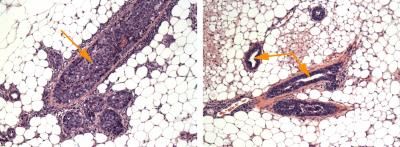
Milk ducts in cancer-prone mice are packed with tumor cells (deep purple cells, shown by arrow), causing the ducts to grow fatter. But milk ducts in mice treated with a gene-silencing nanoparticle remain mostly hollow (right, shown by arrows), like healthy ducts.
Amy Brock
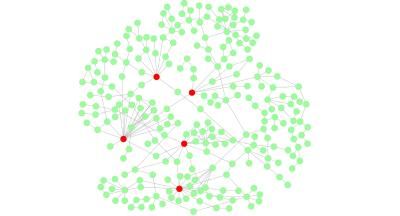
Wyss Institute researchers used a sophisticated mathematical and computational method to reverse-engineer complex gene regulatory networks to find suspect genes (red) that seem to mediate cancer development.
Hu Li/Mayo Clinic
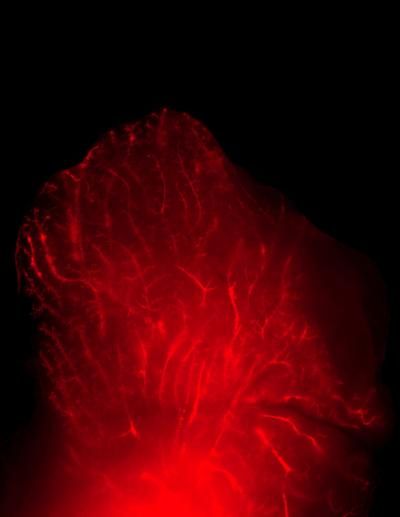
By injecting nanoparticles carrying a gene-silencing snippet of RNA directly into the nipple, Wyss Institute scientists delivered this therapy to the entire milk-duct network, breast cancer first gets started.
Silva Krause and Amy Brock
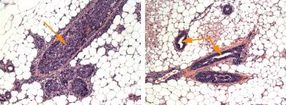
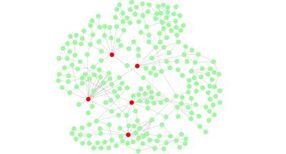
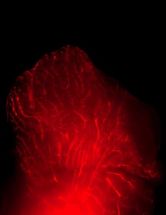
The therapy emerged from a sophisticated effort to reverse-engineer gene networks to identify genes that drive cancer. The same strategy could lead to many new therapies that disable cancer-causing genes no current drugs can stop, and it also can be used to find therapies for other diseases.
"The findings open up the possibility of someday treating patients who have a genetic propensity for cancer, which could change people's lives and alleviate great anxiety," said Don Ingber, M.D., Ph.D., Wyss Institute Founding Director. "The idea would be start giving it early on and sustain treatment throughout life to prevent cancer development or progression." Ingber is also the Judah Folkman Professor of Vascular Biology at Boston Children's Hospital and Harvard Medical School, and Professor of Bioengineering at the Harvard School of Engineering and Applied Sciences.
Between breast self-exams, mammograms, MRIs, and genetic tests, more women than ever are undergoing early tests that reveal precancerous breast tissue. That early diagnosis could potentially save lives; however, few of those lesions go on to become tumors and doctors have no good way of predicting which ones will. As a result, many women currently undergo surgery, chemotherapy and radiation who might never develop the disease. What's more, some women with a high hereditary risk of breast cancer have chosen to undergo preemptive mastectomies.
A therapy that heals rather than kills cancerous tissue could potentially help all these patients, as well as men who develop the disease. But to date the only way to stop cancer cells has been to kill them. Unfortunately, the treatments that accomplish that, including surgery, chemotherapy, and radiation therapy, often damage healthy tissue, causing harsh side effects.
The Wyss Institute researchers thought they could do better by spotting new genes that drive breast cancer and developing targeted genetic therapies to block them. First they had to identify the culprit genes among the thousands that are active in a cell at any moment. Molecular biologists typically convict these culprits through guilt by association; for example, when looking for cancer-causing genes, they search for individual genes that become active as cancer develops. But because genes in cells work in complex networks, that approach has led to some false convictions, with innocent genes being fingered for crimes they did not commit.
To improve the odds of finding the real culprits, Ingber teamed up with Wyss Institute Core Faculty member Jim Collins, Ph.D., a systems biology expert who has developed a sophisticated mathematical and computational method to reverse-engineer bacterial gene networks. Collins is a Core Faculty member at the Wyss Institute for Biologically Inspired Engineering and the William F. Warren Distinguished Professor at Boston University, where he leads the Center of Synthetic Biology.
First, Hu Li, Ph.D. a former Wyss Institute postdoctoral fellow who is now an Assistant Professor of Systems Pharmacology at the Mayo Clinic, honed the computational network to work for the first time on the more complex gene networks of mice and humans. The refined method helped the scientists spot more than 100 genes that acted suspiciously just before milk-duct cells in the breast begin to overgrow. The team narrowed their list down to six genes that turn other genes on or off, and then narrowed it further to a single gene called HoxA1 that had the strongest statistical link to cancer.
The researchers wanted to know if blocking the HoxA1 gene could reverse cancer in lab-grown cells from mouse milk ducts. Amy Brock, Ph.D., a former Wyss Institute postdoctoral fellow who is now an Assistant Professor of Biomedical Engineering at the University of Texas, Austin, grew healthy mouse or human mammary-gland cells in a nutrient-rich, tissue-friendly gel. Healthy cells ensconced in the gel formed hollow spheres of cells akin to a normal milk duct. But cancerous cells, in contrast, packed together into solid, tumor-like spheres.
Brock treated cancerous cells with a short piece of RNA called a small interfering RNA (siRNA) that blocks only the HoxA1 gene. The cells reversed their march to malignancy, stopping their runaway growth and forming hollow balls as healthy cells do. What's more, they specialized as if they were growing in healthy tissue.
The siRNA treatment also stopped breast cancer in a line of mice genetically engineered to have a gene that causes all of them to develop cancer. The Wyss team worked with Michael Goldberg, Ph.D., Assistant Professor of Microbiology and Immunobiology at Harvard Medical School and the Dana-Farber Cancer Institute, to leverage a novel method he had developed to deliver the siRNA efficiently.
They packed the siRNA into nanoparticles called lipidoids that allow for genes to be silenced for weeks inside the body. They then did something unusual: they injected these nanoparticles directly through the nipples into the milk ducts of the cancer-prone mice, using a new method that Silva Krause, Ph.D., a postdoctoral fellow on Ingber's team, had developed. This is important because the cells that line the ducts are the ones that form breast tumors in mice as well as humans.
Weeks went by as Brock and Krause watched. The treated mice remained healthy, while untreated mice developed breast cancer. "There was no aha moment," Brock said. "But after enough evidence builds up, you turn to each other and say this is really doing something here," Brock said.
"We were delighted that we could reverse-engineer mammalian gene networks to identify key disease-causing genes, and we're hopeful that our approach can help uncover new drug targets for many hard-to-treat cancers," Collins said.
Indeed, the work marks a milestone not just in breast cancer research, but in systems biology, Ingber said. "Combining computational, engineering and biological approaches has led to a new way to identify drugs that prevent cancer development and progression."

























































